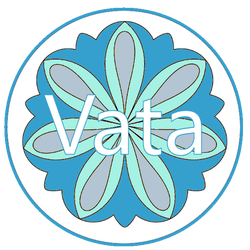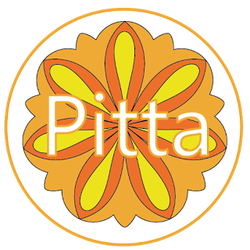The 3 Dosha Types: Vata, Pitta and Kapha

Vata Dosha
Elements: Ether & Air
Characteristics: dry, light, cold, rough, subtle, mobile and clear
Season: Fall
Vata is the energy of movement and governs physical movement, circulation, communication, mental activity, sensory perception, motor function, respiration, heart function and all nervous system impulses.
Vata predominant people are usually lean and thin. They have a slight build with fine features, prominent joints, dry hair and skin. They are active, creative enthusiastic and talkative. They tend to be intelligent and to grasp ideas quickly but may have memory lapses and quickly forget. They are artists, idealists. the spiritual and sensitive healers.
When imbalanced, Vata types tend to respond with nervous energy, may become fearful, nervous and anxious. Imbalances include constipation, flatulence dry skin, cramps, anxiety, insomnia. It can cause tremors spasms, asthma rheumatoid and osteoarthritis as well as many neurological problems .
To Balance Vata: Choose warming foods and minimize intake of raw foods and cold foods and icy drinks. Avoid very cold and very windy conditions, also very dry climates. Minimize travel and too much movement, keep calm and avoid loud and noisy places, crowds, too much talking. Avoid extreme temperatures, keep a regular routine. Eat Sweet Sour and Salty foods ( salt intake should not be excessive). Reduce but don't eliminate Pungent Astringent and Bitter foods . Add warming spices. like cinnamon, cloves, and ginger to your food. This will prevent any digestion issues that Vata types tend to get, as well, as anxiety, dry skin, or insomnia. Sweet berries, fruits, small beans, rice, and all nuts and dairy products are good choices for Vata types. Exercise intensity should be moderate. Tai chi, walking, and swimming are all good for Vata. As much as vatas like movement, they should be mindful of their exercise choices. A fast-paced yoga class can aggravate vata A vata type will benefit from a slower, more restorative type yoga practice with a long 20-30 minute savasana to help ground this dosha.

Pitta Dosha :
Elements: Fire and water
Characteristics: hot, light, mobile, sharp, and oily.
Season: Summer
Pitta is the energy of transformation controlling the body's metabolic systems, including digestion, absorption, nutrition, your body's temperature and is responsible for transforming experience into intelligence.
Pitta predominant people tend to be average in size with a reddish, yellowish or flushed appearance. They can have medium sized eyes with a focused gaze. Their mental expression is passion, intelligence, drive and ambition. They like to learn. Pitta people are cheerful and organized. They are the managers, entrepreneurs, the life of the party.
When imbalanced, they tend toward irritability, impatience, anger and loose stools, inflammations, ulcers, skin problems, vision problems,chronic hypertension, fibromyalgia, gout, inflammatory arthritis,greying and thinning hair.
To Balance Pitta: Avoid over exposure to hot sun and exertion and anxiety. Cut down on heating foods and tastes, oil, salt, hot spices, sour foods, alcohol, red meat and refined flour. Tastes that increase Pitta are pungent (spicy and oily), salty, and sour. The tastes that reduce Pitta are bitter, sweet, and astringent The diet should be easy to digest. Drink adequate quantity of water.Improve fiber intake. Beans, green vegetables, sweet fruits, and vegetables like cauliflower, carrots and broccoli are good. Fresh papaya ,carrot juice, pomegranate juice as well as hibiscus or rose tea and coconut water are excellent for pitta.Most fresh fruits are good except for the acid forming fruits. Cook with cooling spices such as fennel, mint and coriander. For Pittas, it is essential to release heat from your body -- remember, you have element of fire in you. Water sports are great for releasing this heat. Pitta types benefit from a calming restorative, Iyengar of mild Hatha cooling yoga practice with a 15-20 minute savasana.
Elements: Fire and water
Characteristics: hot, light, mobile, sharp, and oily.
Season: Summer
Pitta is the energy of transformation controlling the body's metabolic systems, including digestion, absorption, nutrition, your body's temperature and is responsible for transforming experience into intelligence.
Pitta predominant people tend to be average in size with a reddish, yellowish or flushed appearance. They can have medium sized eyes with a focused gaze. Their mental expression is passion, intelligence, drive and ambition. They like to learn. Pitta people are cheerful and organized. They are the managers, entrepreneurs, the life of the party.
When imbalanced, they tend toward irritability, impatience, anger and loose stools, inflammations, ulcers, skin problems, vision problems,chronic hypertension, fibromyalgia, gout, inflammatory arthritis,greying and thinning hair.
To Balance Pitta: Avoid over exposure to hot sun and exertion and anxiety. Cut down on heating foods and tastes, oil, salt, hot spices, sour foods, alcohol, red meat and refined flour. Tastes that increase Pitta are pungent (spicy and oily), salty, and sour. The tastes that reduce Pitta are bitter, sweet, and astringent The diet should be easy to digest. Drink adequate quantity of water.Improve fiber intake. Beans, green vegetables, sweet fruits, and vegetables like cauliflower, carrots and broccoli are good. Fresh papaya ,carrot juice, pomegranate juice as well as hibiscus or rose tea and coconut water are excellent for pitta.Most fresh fruits are good except for the acid forming fruits. Cook with cooling spices such as fennel, mint and coriander. For Pittas, it is essential to release heat from your body -- remember, you have element of fire in you. Water sports are great for releasing this heat. Pitta types benefit from a calming restorative, Iyengar of mild Hatha cooling yoga practice with a 15-20 minute savasana.

Kapha Dosha:
Elements: Water and Earth
Charactersitics: Heavy, slow, steady, solid, cold, soft, oily
Season: When winter is transitioning to spring
Kapha is responsible for cohesion & lubrication. It governs the structure of the body. It is the principle that holds the cells together and forms the muscle, fat, bone, and sinew.
Kapha predominant people tend to have large strong strong structure, great fertility and endurance. They have rich moist skin and hair. They have good long term memory, but take their time learning. They have a deep understanding of people and are the pillars of society- caring, loving, patient and strong. They like regularity, however they can miss a meal without losing energy and they don't like to exercise.
Kapha imbalance can cause slow digestion, weight problems, lung and head congestion, asthma, diabetes, high cholesterol, edema, asthma,tumors . Psychological imbalances include the emotions of depression, attachment, greed, and long-standing grudges or envy can emerge. They can also be possessive and withdrawn.
To Balance Kapha: Favor warm foods and hot beverages. Eat a minimum of oil and fat. Avoid cold drinks, cold food, and frozen desserts, such as: ice cream. Tastes that increase Kapha are sweet sour and salty foods and tastes that pacify Kapha are pungent, astringent and bitter. Use lots of spices such as black pepper, ginger, cumin, chili and lots of bitter dark greens.
It is difficult to get a Kapha person to exercise as they are prone to sluggishenss and being overweight, however Kapha types need to be active on a daily basis. For Kaphas, running, lifting weights, rowing, swimming, aerobics. A yoga practice for a Kapha type should be faster paced, more intense and challenging with a relatively short savasana ( 5-10 minutes) so as not to fall asleep.
·
Elements: Water and Earth
Charactersitics: Heavy, slow, steady, solid, cold, soft, oily
Season: When winter is transitioning to spring
Kapha is responsible for cohesion & lubrication. It governs the structure of the body. It is the principle that holds the cells together and forms the muscle, fat, bone, and sinew.
Kapha predominant people tend to have large strong strong structure, great fertility and endurance. They have rich moist skin and hair. They have good long term memory, but take their time learning. They have a deep understanding of people and are the pillars of society- caring, loving, patient and strong. They like regularity, however they can miss a meal without losing energy and they don't like to exercise.
Kapha imbalance can cause slow digestion, weight problems, lung and head congestion, asthma, diabetes, high cholesterol, edema, asthma,tumors . Psychological imbalances include the emotions of depression, attachment, greed, and long-standing grudges or envy can emerge. They can also be possessive and withdrawn.
To Balance Kapha: Favor warm foods and hot beverages. Eat a minimum of oil and fat. Avoid cold drinks, cold food, and frozen desserts, such as: ice cream. Tastes that increase Kapha are sweet sour and salty foods and tastes that pacify Kapha are pungent, astringent and bitter. Use lots of spices such as black pepper, ginger, cumin, chili and lots of bitter dark greens.
It is difficult to get a Kapha person to exercise as they are prone to sluggishenss and being overweight, however Kapha types need to be active on a daily basis. For Kaphas, running, lifting weights, rowing, swimming, aerobics. A yoga practice for a Kapha type should be faster paced, more intense and challenging with a relatively short savasana ( 5-10 minutes) so as not to fall asleep.
·

